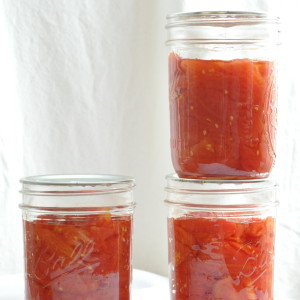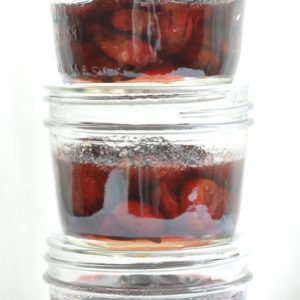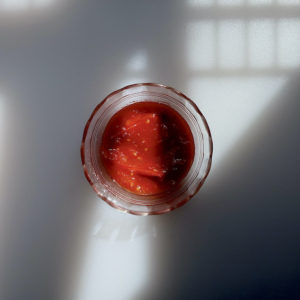On Canning
A few words on safe canning practices might be useful as we move into spring. Today’s post is an overview, as a comprehensive lesson would be overwhelmingly long. As it is, this post is already too long. Sorry for that. But I had a post on cherry jam all ready to go, and realized it assumed knowledge people may not have. How many recipes do you encounter that say things like “Preserve jam in a water bath canner, following the instructions that came with your canner,” or some such nonsense? I hate that. It’s such a cop out.
Rest assured the IK won’t be offering a glut of canning recipes. Much as I enjoy canning, I realize it isn’t for everyone, so I’ll continue doing what I’ve done until now: offer recipes that work whether you can them or not.

Many people find canning a terrifying proposition. Words like botulism toxin are enough to put anyone off. Occasional news articles about picnics gone horribly awry courtesy of somebody’s well-meaning but archaic relish recipe don’t help matters. But common sense, good hygiene, and few simple rules are all you need to can safely.
Good instructional manuals also help. I can’t say enough about Eugenia Bone’s Well-Preserved. I taught myself to can from it.

Canning tends to conjure visions of hot kitchens and thousands of jars of food that never get eaten. Sure, you could go this route, but small-batch canning is a better idea: put up two or five or eight jars of something you truly enjoy.
People will tell you there’s no practical reason to can, and they’re right. But this line of reasoning applies to all cooking. Only you can decide where to draw the line. There’s no practical reason to bake bread, make duck confit, stir fry at home, or churn ice cream. There is certainly no reason for people to brew their own beer, make their own limoncello, or attempt paté sucree. But people do.

Canners argue for seasonal eating, supporting local farmers, and knowing what goes into your jars. There’s the ready gift factor and the artisanal crafting aspect. There’s sidestepping Big Ag.

Honestly, I don’t preserve for any of these reasons. I came to canning in my early forties. My husband and I were living in a condo with an electric oven whose burners heated to varying temperatures. I was working full-time. The total concentration demanded by canning completely hooked me. That I ended up with useful jars filled with delicious food afterward only sweetened the deal. The entire act of canning–purchasing fresh produce, prepping it, laying out the jars, lids, and bands–was and is enormously relaxing. One is effecting a perfectly ordered, immaculate world from which issues wonderful food. Share this food with other people and they are amazed and grateful.

Further, canning is a wonderful pastime for the messed up. On days I am too wrecked to cook, I can open a few jars. Within minutes a lovely soup on the table. This is much cheaper than ordering pizza.
Yes, canning takes time. All good things do. Eugenia Bone writes:
“Because it takes time and care to accomplish, the craft of home canning slows down my relationship with food.”
Bone goes on to say that canning is an optimistic act, one that looks to the future, for canned food isn’t intended for immediate consumption. Certain recipes, like pressure canned tuna, have seasoning periods of several months. To can assumes a future of pleasant meals.
Whatever is happening in your life the day you can will be packed into the jars with the food. Months later, when you open said jar or revisit that recipe, restocking for the year ahead, memory will float out. Earlier this week, as I pitted cherries for jam, I suddenly recalled doing the same thing a year earlier. Workmen were installing a ceiling lift in our bedroom. The house was hot, dusty, noisy. I’d been upset at the upheaval, at the need for the lift. But the cherries were beautiful. Pitting them had soothed me. This photograph was taken then, shortly before the IK started.

—
There are two kinds of canning, water bath and pressure. This is a water bath canner:

Nothing fancy. I bought this at a hardware store for a whopping $25. People are always writing about ways to rig up water bath canners. For $25, I say just buy the damned thing already.
Caveat: Eugenia Bone uses an asparagus pan to water bath can single jars while preparing meals. This is a terrific idea for putting up small amounts.
Further caveat: Please don’t be tempted by those newfangled “home canning systems.” Do you remember bread machines? How they only worked with their specific recipes? How all the breads tasted exactly the same? Electronic home canning systems only work using their specific recipes. They are no more about canning than bread machines are about baking bread.

Water bath canners are used to can fruits and vegetables with pH of 4.5 or lower. The food can either naturally be this acidic or, more commonly, you can alter the pH with sugar, salt, vinegar, lemon juice, or citric acid.
Some foods cannot be canned in a water bath, no matter what you add to them. They’re too dense, unable to be sufficiently acidified, or the canner cannot get hot enough to kill molds, toxins, or other spoilers. Never water bath can meats, fish, or poultry. If you can’t find a recipe for a certain fruit or vegetable, it means there isn’t a safe way to water bath can it. Don’t try it.
Again, there are excellent canning manuals out there, and I encourage you to invest in a couple:

Do not sneer at Putting Food By’s dated cover. This wonderfully comprehensive book walks you through just about any preserving scenario.These are the people you turn to when that jar doesn’t seal. If they’re a bit fanatic about cleanliness, better that than the opposite.

The USDA’s Complete Guide To Home Canning and Preserving may not be riveting bedside reading, but it is an invaluable resource for pressure canners, offering best methods and timing for all sorts of food. Not sure how long those green bean go in? Forgot the timing for chicken broth? This is your book.
For foods with a pH above 4.6 you need a pressure canner:

Notice some important features the water bath canner doesn’t have:

A temperature gauge. And:

A weight.
Briefly, pressure canners cook food at high heat–240F–under pressure for a certain length of time, depending on the food. How much pressure depends on your altitude. People living at sea level pressure can at 10 pounds. People living 1000 feet above sea level need to use the 15 pound setting. The 5 pound setting is for pressure cooking, not canning.
While pressure canners may look a bit ominous, they only look that way. And while people are snobby about canned vegetables, especially here in the land of Alice Waters, I dare anyone to taste plain pressure canned vegetables and balk. Asparagus, wax beans, and corn are delicious pressure canned in water and a teaspoon of salt. In the middle of January, they’re an absolute luxury. The incidental broths from boiled beef, chicken or ham hocks are all marvelous pressure canned. And in a house where storage is at a premium, it’s easier to store a shelf-stable jar than find space in the freezer.

On Cleanliness…..
Canning does not require surgical sterility.
Wash you hands. Wipe down your counters. Rinse the food. To sterilize jars, I wash them in hot, soapy tap water, then dry them in my oven on the lowest setting, which is 170 degrees. New lids are dropped into a pot of boiling water (they need to be softened before capping a jar). I re-use bands, so they always get a soapy wash before joining the lids in the boiling water pot.

If a jar doesn’t seal….
Normally you’ll know right away if a seal fails. Occasionally I’ll have one or two jars that don’t seal. Usually the jar lip wasn’t clean or just, well, because.
You have the option of re-processing the food in a clean jar, though double-processing is very hard on food; you are essentially double-cooking it. You can also refrigerate or freeze it, and then bring it to a boil for ten minutes once you plan to serve it. Or, if you’re paranoid, you can pitch it.
Botulism is scary because it’s hard to kill. Also because it’s invisible and, well, it can kill you. A few months ago I pressure canned several jars of chicken broth. The seals seemed good, so I put them away. About a week later, I reached for one and the lid came off. Normally jar lids need to be pried off with the tip of a paring knife. I searched out the other jars from that canning session, and sure enough, the lids had all loosened.
Nothing smelled or otherwise looked amiss. Nevertheless, you cannot be too careful.
Having already stupidly touched one jar barehanded, I fetched my jug of janitor-grade ammonia, which carries warnings about diluting with water before using. I washed my hands with the straight stuff–burns or death? Gee, let me think….then I diluted it, donned gloves, topped up my spray bottle, and got two thick garbage bags. The jars, complete with contents, went into the bags, which I carefully tied shut. We live in an urban area; our trash bin lives in the garage until trash day. I buried the bags at the bottom of the bin. Returning to the house, I ammonia’d everything that might possibly have had contact with the tainted broth–sink, door handles, counters. The paper towels and gloves were duly tossed.
I think this was the only time I dealt with a botulism concern. I am here to tell the tale.
When in doubt, throw it out.
—
Had anyone told my younger self that middle age would see me a canning convert, waving my jar lifter and tongs to all and sundry, I would have thought that person mad. Which shows you how little we know of ourselves, and how the lives we plan for often end up immeasurably distant from the lives we end up living.





